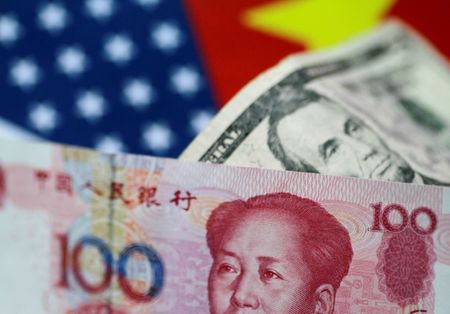Forex
Asia FX rally stalls on China weakness, dollar steadies before PCE data


© Reuters.
Investing.com– Most Asian currencies kept to a tight range on Thursday tracking weak economic signals from China, while the dollar steadied from recent losses as markets awaited a key inflation reading due later in the day.
The strengthened slightly after a stronger midpoint fix from the People’s Bank of China. But purchasing managers index data showed a sustained decline in , as China’s biggest economic engines struggled with worsening overseas demand.
The reading highlighted continued weakness in the Chinese economy, as a post-COVID rebound failed to materialize.
But steady PBOC support, coupled with a less hawkish outlook for the Federal Reserve saw the yuan set for a 2.6% gain in November. The currency also remained close to a five-month high against the dollar.
Other Asian units moved little on Thursday as a weeks-long rally in regional currency markets now appeared to be winding down. But most regional units were set for stellar gains in November, as markets grew convinced that the Fed will raise interest rates no further.
The rose 0.1%, taking little support from data that showed grew less than expected in October, while remained muted.
Still, the yen marked a sharp recovery from near 33-year lows in November, and was set to rise 3% in the month, its best monthly gain since November 2022, when the government had intervened in currency markets.
The rose 0.4%, buoyed by data showing a rebound in through October. But Australian remained weak in the third quarter.
The Australian dollar was set to nearly 5% in November, and was trading close to a four-month high.
The fell slightly on Thursday as the held interest rates steady, as widely expected. But weak and data pointed to sustained weakness in the South Korean economy.
Still, the won was on course for a 4.5% jump in November.
The was the sole outlier among Asian currencies in November, and was set for a muted monthly performance after sinking to record lows earlier. The currency was battered by increased domestic demand for dollars, as well as concerns over the Reserve Bank’s dwindling dollar reserves.
Indian for the September quarter were due later in the day, and were expected to show sustained growth in the fastest-growing major economy.
Dollar steadies near 3-½ month lows, PCE inflation data awaited
The and moved little in Asian trade on Thursday, after recovering slightly from their lowest levels since mid-August. But the greenback was still set to lose 3.6% in November- its worst month in a year.
Softening U.S. inflation and signs of a cooling labor market drove steep losses in the dollar through November, amid growing conviction that the . Markets were now seeking signals on when the bank could potentially begin trimming rates in 2024, with some Fed officials suggested that loosening may come earlier if inflation continued to decline.
To that end, focus was now squarely on data- the Fed’s preferred inflation gauge, due later in the day. A second reading on U.S. was also on tap later in the day, while for November, as well as a speech by , were due on Friday.

 Forex3 years ago
Forex3 years agoForex Today: the dollar is gaining strength amid gloomy sentiment at the start of the Fed’s week

 Forex3 years ago
Forex3 years agoUnbiased review of Pocket Option broker

 Forex3 years ago
Forex3 years agoDollar to pound sterling exchange rate today: Pound plummeted to its lowest since 1985

 Forex3 years ago
Forex3 years agoHow is the Australian dollar doing today?

 Cryptocurrency3 years ago
Cryptocurrency3 years agoWhat happened in the crypto market – current events today

 World3 years ago
World3 years agoWhy are modern video games an art form?

 Commodities3 years ago
Commodities3 years agoCopper continues to fall in price on expectations of lower demand in China

 Economy3 years ago
Economy3 years agoCrude oil tankers double in price due to EU anti-Russian sanctions























